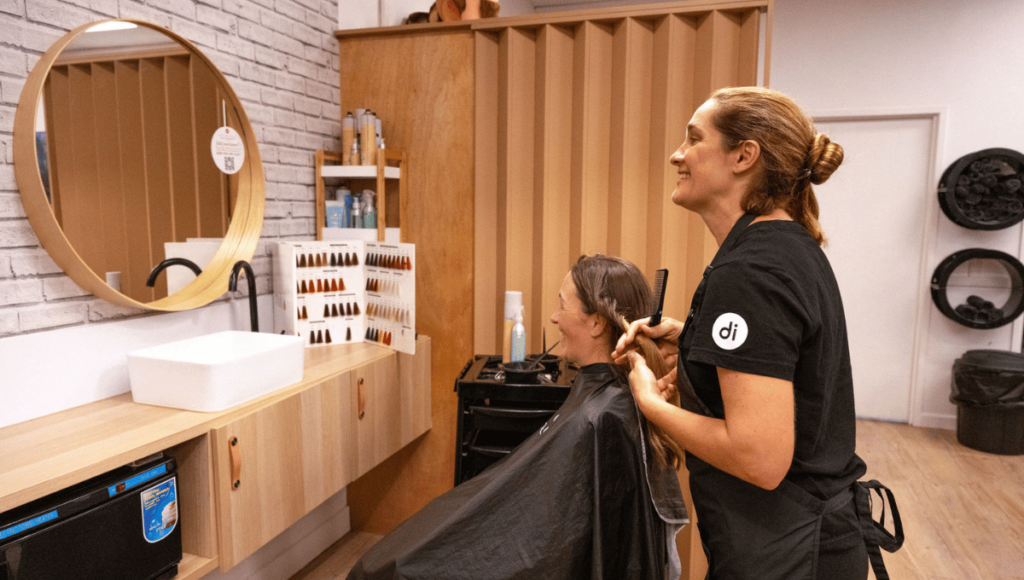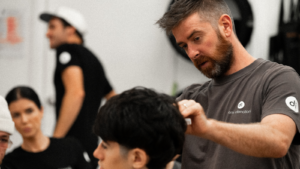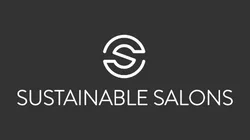Ready to kickstart your career as a professional hairdresser or barber? If you’re at a crossroads with your training options, we’re here to help! Not everyone follows the same career pathway, and that’s okay. Your choice should come down to which hairdressing training program suits your learning style and, of course, your lifestyle.
While hairdressing apprenticeship options have traditionally been popular, fast-track hairdressing courses are quickly becoming a crowd favourite, especially for anyone looking to start their careers sooner—and with greater earning potential. #BossMove
With so many options out there, it can be tricky to know where to start. We’ve teamed up with industry experts and Demi trainers Jay Matai and Jeff Jowett to help guide you through hairdressing apprenticeships and hairdressing short courses, so you can choose the best path for your career.
Hairdressing apprenticeships: the good, the bad and the reality
For those eyeing a career as a hairdresser or barber, an apprenticeship has been the go-to route for decades. You’d find a salon or barbershop, roll up your sleeves, and learn the ropes through hands-on work. Some would argue it’s jumping straight into the deep end, but is it the best way? The low pay rates and considerable time commitment to complete a hairdressing apprenticeship drive many people to look for other options.
Jay Matai, barbershop business owner and Demi International trainer, doesn’t believe that apprenticeships are necessarily a bad option, commenting, “I think they provide an incredible career learning journey”. But times are changing. Reduced government incentives to business owners are impacting this pathway. “When I purchased my salon, hiring an apprentice was a straightforward decision because the government subsidised 50% of the apprentice’s wage at the time. However, government incentives for apprentices have significantly decreased in recent years, making it difficult for small businesses to justify employing apprentices,” he claims.
The pros and cons of a hairdressing apprenticeship
Jeff Jowett, one of Demi International’s skilled barber trainers, also knows this space well. A hairdressing apprenticeship is how he started his career back in 1983—and while he’s proud of the journey he’s taken, he’s also got some advice for those just starting out.
“The practical ‘on-the-job’ training of an apprenticeship was invaluable when I started”, Jeff claims, “But now there are more opportunities. When I started my journey to become a hairdresser, the only alternative to a traditional apprenticeship was a six-month pre-hairdressing apprenticeship TAFE course. These days, students have so much more to choose from, with more comprehensive, faster—and better—courses available. I’d recommend students explore all options before settling on a hairdressing apprenticeship, just to make sure it’s the right fit.” he adds.
How long is a hairdressing apprenticeship?
A traditional hairdressing apprenticeship typically takes 3 to 4 years to complete, and barbering apprenticeships fall within a similar timeframe. This extended period provides on-the-job training, but it also means you’ll be earning entry-level wages until you’re fully qualified.
You may also find you have limitations on the type of hair treatments and styles you’re allowed to perform as a junior.
Hairdressing apprenticeship pay
If you’re looking into hairdressing wages, you’ll find hairdressing apprenticeship pay starts low. Junior apprentices earn around $13.58 an hour, while an adult hairdressing apprentice makes around $25.65 per hour.
To compare, a qualified hairdresser or barber who has studied an industry-accredited hairdressing course could earn around $35 per hour as an adult—potentially more depending on where you work. Over a year, that’s almost $20,000 more you could be earning compared to an adult apprentice.
According to Jeff, though, no set path guarantees more money. “Wages can be negotiated depending on skills,” he says. “A business will determine an employee’s worth to the business based on qualifications and experience.”
Fast-track hairdressing courses: higher qualification, greater earning potential
An attractive alternative for many is the fast-track hairdressing course, also known as Certificate III. Jay recommends this avenue over apprenticeships and shares his experience both as a trainer and business owner. “It’s faster. Way faster, 6 terms instead of 4 years for Hairdressing. Barbering is only 5 terms. This means that you can earn more—quicker!” And it’s not just about the pay, “You get practical experience from the beginning and you’ll build a professional network with like-minded learners and educators, which you can use throughout your career.” he adds. “It also helps you avoid the hassle of finding a business to take you on as an apprentice.”
As Jay suggests, our Demi International SHB30416 Certificate III in Hairdressing requires only two days a week on campus, across 6 x 10-week terms, and only 7 hours of independent study per week. So you can study around your existing career or personal commitments.
If becoming a barber is your thing, our SHB30516 Certificate III in Barbering runs for five terms with just one day per week on campus, plus independent study.
The perks of fast-track hairdressing courses
Whether you’re a young student aiming to graduate quickly or a mature student looking to fast-track your studies, the shorter completion time and greater career prospects of a Certificate III are definitely appealing. As Jeff puts it:
“From my experience, fast-track hairdressing courses like our Certificate III are a game-changer. Not only do they get you into the industry quicker, but they also offer a comprehensive education. Our students learn everything from cutting and styling to business management. I’ve seen students transform their passion for hairdressing into successful careers in no time.”
As Jeff mentions, another added benefit of our Certificate III programs is that you’ll not only learn how to cut and style, but you’ll also learn how to build a brand. Business acumen is a skill in demand, and our courses include core skills that’ll help you understand how to run a business effectively. If you want to dive deeper or salon management is where you’re headed, check out our SHB50216 Diploma of Salon Management and graduate with more opportunities.
Do hairdressing courses have salon training?
A common concern with off-site hairdressing courses or TAFE apprenticeships is that they’re not equipped with a real salon to give you the most authentic experience. At Demi, we’ve solved this with our student salons. These real-life salons are purpose-built to ensure you get the practical learning you need in a setting designed for learners.
Hairdressing course funding options
While fast-track courses aren’t covered by the Queensland Government’s Certificate 3 Guarantee, Demi International offers flexible payment plans for all students. This way, you can focus on studying without the financial stress.
Which study pathway is best for you?
Every student is as unique as their haircut! So, there’s no single study pathway that works for everyone. Here are some of our top summary points that might help you decide which is right for you:
- Time: if you’re keen on working as a qualified hairdresser or barber straight away, you’ll probably enjoy a fast-tracked course, allowing you to enter the workforce in 72 weeks.
- Money: apprentices are paid a set apprentice wage during training, with the potential to start earning better money once qualified. If you’re graduating from a fast-tracked hairdressing or barbering course, you’ll likely earn a full wage as soon as you have your qualification, with pay increasing corresponding to experience.
- Career goals: think about your long-term. An apprenticeship can show you all aspects of hairdressing and barbering. However, bundled courses with salon management may give you a better platform to succeed.
- Learning style: are you a hands-on learner, or do you prefer to study at your own pace, including practical work? Your learning style can help you choose the best approach and ensure that you stick with it.
Jeff reiterates the importance of listening to your trainer and keeping attendance up, regardless of your path. “Your trainer is your best learning tool, and they’ve got the day-to-day experience to give you inspiration. Attend every class and take advantage of what’s on offer; it’ll be your loss if you don’t show up.”
Why choose Demi?
Not long ago, we shared John’s story, a tradie turned trimmer who was inspired by a ‘mafia-movie’ barbershop. At Demi, John was able to learn at his own pace and build a profitable business, and he’s just one of our many success stories. We’re proud of our world-class study in a down-to-earth environment.
It’s no surprise Demi was awarded Queensland’s Small Training Provider of the Year, not just for the training programs we provide, but the ongoing support and community we build for our students and staff.
Finding your path starts here
Ultimately, the best pathway for you depends on your goals, timeline and learning style. Whether you prefer the hands-on approach of an apprenticeship or the fast-paced efficiency of a Certificate III, Demi International can help you find the right fit.
Chat with one of our friendly Course Advisors today to explore your options, start dates and flexible payment plans. Your future in hairdressing or barbering starts here!







